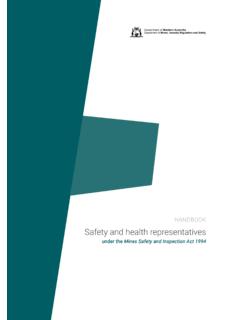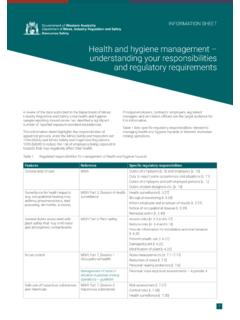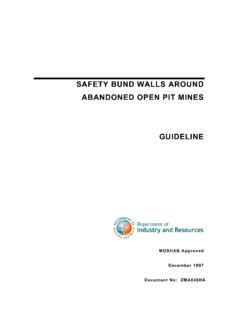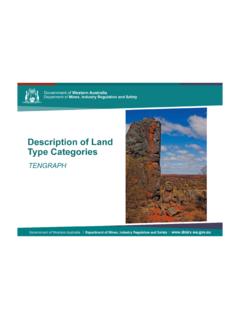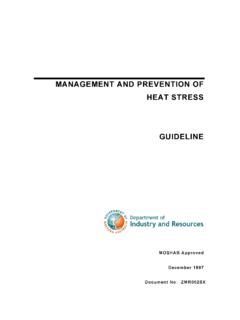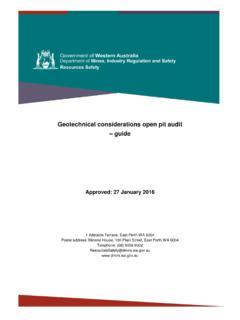Transcription of Dangerous Goods Safety Guidance Note Licensing and ...
1 Dangerous Goods Safety Guidance Note Licensing and exemptions for storage and handling January 2015 1 Adelaide Terrace, East Perth WA 6004 Postal address: Mineral House, 100 Plain Street, East Perth WA 6004 Telephone: (08) 9358 8002 Facsimile: (08) 9358 8000 DGS Guidance Note, January 2015 Licensing and exemptions for storage and handling Page 2 of 16 Contents Introduction .. 3 Does the quantity of Dangerous Goods I have require Licensing ? .. 3 Calculating quantity of Dangerous Goods .. 3 When is Licensing not required? .. 4 Multiple sub-manifest quantity storages .. 4 storage for up to six months of up to three times the manifest quantity .. 4 Rural Dangerous Goods locations .. 4 Applying for a licence .. 4 Major hazard facility (MHF) screening.
2 5 Appendix 1 Definitions .. 6 Appendix 2 Technical information for common Dangerous Goods .. 7 Appendix 3 Manifest quantities of Dangerous Goods .. 9 Appendix 4 Calculation of quantity on a Dangerous Goods site .. 10 Appendix 5 Information required in a licence application .. 12 Appendix 6 Critical quantities for potential MHFs .. 15 Appendix 7 Approved codes of practice .. 16 DGS Guidance Note, January 2015 Licensing and exemptions for storage and handling Page 3 of 16 Introduction This Guidance note will assist people wishing to store, handle or process Dangerous Goods in Western Australia to determine whether Licensing applies and, if so, what information is required for the Licensing process. The definitive statutory requirements are contained in the Dangerous Goods Safety ( storage and handling of Non- explosives ) regulations 2007 (the storage and handling regulations ).
3 These regulations apply to the manufacture, processing, disposal, storage and use of Dangerous Goods . Note: The regulations do not include explosives , infectious substances and radioactive substances. Some commonly used terms in the determinations are defined in Appendix 1. Appendix 2 lists some common Dangerous Goods and related classification information. All forms referred to in this Guidance note are available from the Resources Safety website in the Dangerous Goods forms section. Does the quantity of Dangerous Goods I have require Licensing ? Unless otherwise exempted (see When is Licensing not required? ), a site must be licensed if Dangerous Goods are stored or handled at the site in quantities that exceed the manifest quantities (Appendix 3). Calculating quantity of Dangerous Goods All Dangerous Goods present, including those in packages, bulk storage , process vessels, pipelines and equipment, must be taken into account when calculating the quantity of Dangerous Goods on a site.
4 The calculation used to determine the quantity depends on the type of Dangerous Goods and how they are contained. An example is given in Appendix 4. Packaged Dangerous Goods Gases total capacity of the container (see note below) Liquids capacity of the container All other packaged Dangerous Goods mass in kilograms of the Goods in the container. Bulk Dangerous Goods Gases total capacity of the container (see note below) Liquids design capacity of the container Uncontained solid Dangerous Goods undivided mass in kilograms All other bulk Dangerous Goods mass in kilograms that the container is designed to hold. Dangerous Goods in storage or handling system other than a container Gases and liquids capacity of the storage or handling system Solid Dangerous Goods mass of the Goods in the system.
5 Articles or things Dangerous Goods that are articles or things net quantity of that part of the articles or things that in itself comprises Dangerous Goods . Note: For multiple-element gas containers (MEGCs), capacity is determined as the sum of capacities of all manifolded cylinders. DGS Guidance Note, January 2015 Licensing and exemptions for storage and handling Page 4 of 16 When is Licensing not required? Multiple sub-manifest quantity storages Licensing is not required, despite having quantities of Dangerous Goods in excess of the manifest quantity, if: the Dangerous Goods are stored in more than one area on the site; and the quantity of Dangerous Goods stored in each area is less than the manifest quantity; and each area is located outdoors or in a separate building dedicated to storage or handling of the Dangerous Goods ; and each such area is separated from every other such area by a distance sufficient to ensure that a Dangerous Goods incident in one area cannot cause a Dangerous Goods incident in another area.
6 storage for up to six months of up to three times the manifest quantity Licensing is not required, despite having quantities of Dangerous Goods in excess of the manifest quantity, if: Dangerous Goods are stored or handled at the site for not more than six months; and Dangerous Goods are not manufactured or processed at the site; and the quantity of Dangerous Goods does not exceed three times the manifest quantity; and the site is not a major hazard facility; and the operator of the site has undertaken a risk assessment; and the operator of the site has notified the Chief Officer in writing (using the Notification of temporary storage or handling of Dangerous Goods form) of the intention to store or handle the Dangerous Goods at the site; and the operator of the site complies with any directions given by the Chief Officer in relation to the storage and handling of the Dangerous Goods .
7 Rural Dangerous Goods locations A rural Dangerous Goods location is specifically excluded from the definition of a Dangerous Goods site, and hence such locations do not require Licensing under the storage and handling regulations . A rural Dangerous Goods location is defined as a location: outside the limits of the metropolitan area, as defined in the Planning and Development Act 2005 section 4(1), and is not within a townsite, as defined in the Land Administration Act 1997 section 3(1); and of an area of 5 hectares or larger; and used for agricultural, horticultural, floricultural, aquacultural or pastoral purposes; and where the Dangerous Goods stored or handled on the site are not for sale, and are for use on the site in the primary production activities listed above.
8 Although these locations are not required to be licensed, storage and handling in these locations must comply with relevant requirements in the storage and handling regulations ( regulations 123 133). Applying for a licence An application for a Dangerous Goods site licence must be made on the approved form, which is available from the forms section of the Resources Safety website. You should engage the services of an accredited consultant to assist you in the preparation and endorsement of your application for a licence. DGS Guidance Note, January 2015 Licensing and exemptions for storage and handling Page 5 of 16 A list of consultants accredited by the Chief Officer to examine applications for compliance with the Dangerous Goods Safety Act 2004 and storage and handling regulations is available from the Resources Safety website (go to the Dangerous Goods section and select the storage and handling heading under Guidance material).
9 See Appendix 5 for detailed Guidance on how to lodge a licence application. The application form also includes information on the application process. Major hazard facility (MHF) screening Stores of licensable quantities of Dangerous Goods above certain thresholds are subject to assessment to determine if the sites are to be managed as major hazard facilities under the Dangerous Goods Safety (Major Hazard Facilities) regulations 2007 (the MHF regulations ). Applications for Dangerous Goods sites where Dangerous Goods may be present above a critical quantity of 10% of the major hazard facility threshold are screened by Resources Safety to determine if the storage site should be declared as a major hazard facility. Some critical quantities at which screening is required for Dangerous Goods sites as potential MHFs are given in Appendix 6 (see the MHF regulations for a full list).
10 The screening process is initiated when Resources Safety receives an Operator notification that critical quantity of Schedule 1 substances will be exceeded form. DGS Guidance Note, January 2015 Licensing and exemptions for storage and handling Page 6 of 16 Appendix 1 Definitions ADG Code means the Australian Code for the Transport of Dangerous Goods by Road and Rail, seventh edition, 2007 . Bulk, in relation to Dangerous Goods , means an undivided quantity of Dangerous Goods exceeding 500 kg, or Dangerous Goods in a container that has a capacity greater than 500 L or is designed to hold more than 500 kg. Class or division means the class or division assigned to Dangerous Goods under the ADG code, subject to Regulation 8 of the storage and handling regulations . In relation to Dangerous Goods , handling includes to manufacture, process, pack, use, sell, supply, carry (including by pipeline), and treat Dangerous Goods , including their destruction or disposal.
